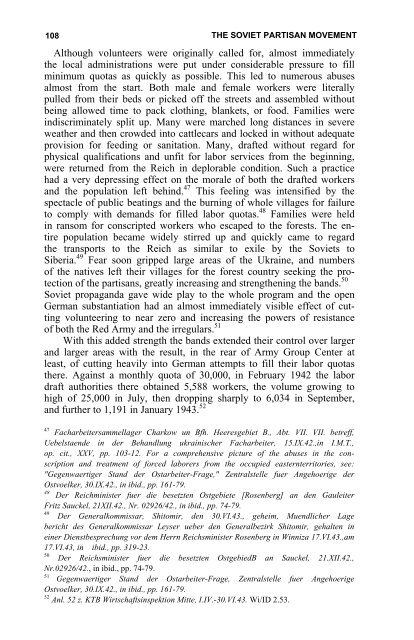the soviet partisan movement 1941-1944 by edgar m. howell
the soviet partisan movement 1941-1944 by edgar m. howell
the soviet partisan movement 1941-1944 by edgar m. howell
You also want an ePaper? Increase the reach of your titles
YUMPU automatically turns print PDFs into web optimized ePapers that Google loves.
108 THE SOVIET PARTISAN MOVEMENT<br />
Although volunteers were originally called for, almost immediately<br />
<strong>the</strong> local administrations were put under considerable pressure to fill<br />
minimum quotas as quickly as possible. This led to numerous abuses<br />
almost from <strong>the</strong> start. Both male and female workers were literally<br />
pulled from <strong>the</strong>ir beds or picked off <strong>the</strong> streets and assembled without<br />
being allowed time to pack clothing, blankets, or food. Families were<br />
indiscriminately split up. Many were marched long distances in severe<br />
wea<strong>the</strong>r and <strong>the</strong>n crowded into cattlecars and locked in without adequate<br />
provision for feeding or sanitation. Many, drafted without regard for<br />
physical qualifications and unfit for labor services from <strong>the</strong> beginning,<br />
were returned from <strong>the</strong> Reich in deplorable condition. Such a practice<br />
had a very depressing effect on <strong>the</strong> morale of both <strong>the</strong> drafted workers<br />
and <strong>the</strong> population left behind. 47 This feeling was intensified <strong>by</strong> <strong>the</strong><br />
spectacle of public beatings and <strong>the</strong> burning of whole villages for failure<br />
to comply with demands for filled labor quotas. 48 Families were held<br />
in ransom for conscripted workers who escaped to <strong>the</strong> forests. The entire<br />
population became widely stirred up and quickly came to regard<br />
<strong>the</strong> transports to <strong>the</strong> Reich as similar to exile <strong>by</strong> <strong>the</strong> Soviets to<br />
Siberia. 49 Fear soon gripped large areas of <strong>the</strong> Ukraine, and numbers<br />
of <strong>the</strong> natives left <strong>the</strong>ir villages for <strong>the</strong> forest country seeking <strong>the</strong> protection<br />
of <strong>the</strong> <strong>partisan</strong>s, greatly increasing and streng<strong>the</strong>ning <strong>the</strong> bands. 50<br />
Soviet propaganda gave wide play to <strong>the</strong> whole program and <strong>the</strong> open<br />
German substantiation had an almost immediately visible effect of cutting<br />
volunteering to near zero and increasing <strong>the</strong> powers of resistance<br />
of both <strong>the</strong> Red Army and <strong>the</strong> irregulars. 51<br />
With this added strength <strong>the</strong> bands extended <strong>the</strong>ir control over larger<br />
and larger areas with <strong>the</strong> result, in <strong>the</strong> rear of Army Group Center at<br />
least, of cutting heavily into German attempts to fill <strong>the</strong>ir labor quotas<br />
<strong>the</strong>re. Against a monthly quota of 30,000, in February 1942 <strong>the</strong> labor<br />
draft authorities <strong>the</strong>re obtained 5,588 workers, <strong>the</strong> volume growing to<br />
high of 25,000 in July, <strong>the</strong>n dropping sharply to 6,034 in September,<br />
and fur<strong>the</strong>r to 1,191 in January 1943. 52<br />
47 Facharbeitersammellager Charkow un Bfh. Heeresgebiet B., Abt. VII. VII. betreff,<br />
Uebelstaende in der Behandlung ukrainischer Facharbeiter, 15.IX.42.,in I.M.T.,<br />
op. cit., XXV, pp. 103-12. For a comprehensive picture of <strong>the</strong> abuses in <strong>the</strong> conscription<br />
and treatment of forced laborers from <strong>the</strong> occupied easternterritories, see: <br />
"Gegenwaertiger Stand der Ostarbeiter-Frage," Zentralstelle fuer Angehoerige der<br />
Ostvoelker, 30.IX.42., in ibid., pp. 161-79.<br />
48<br />
Der Reichminister fuer die besetzten Ostgebiete [Rosenberg] an den Gauleiter<br />
Fritz Sauckel, 21XII.42., Nr. 02926/42., in ibid., pp. 74-79.<br />
49<br />
Der Generalkommissar, Shitomir, den 30.VI.43., geheim, Muendlicher Lage<br />
bericht des Generalkommissar Leyser ueber den Generalbezirk Shitomir, gehalten in <br />
einer Dienstbesprechung vor dem Herrn Reichsminister Rosenberg in Winniza 17.VI.43.,am <br />
17.VI.43, in ibid., pp. 319-23.<br />
50<br />
Der Reichsminister fuer die besetzten OstgebiedB an Sauckel, 21.XII.42.,<br />
Nr.02926/42., in ibid., pp. 74-79.<br />
51<br />
Gegenwaertiger Stand der Ostarbeiter-Frage, Zentralstelle fuer Angehoerige<br />
Ostvoelker, 30.IX.42., in ibid., pp. 161-79.<br />
52 Anl. 52 z. KTB Wirtschaftsinspektion Mitte, I.IV.-30.VI.43. Wi/ID 2.53.
















